Buyer's Guide: 1928-1931 Ford Model A
Almost a century later, the Model A is still one of the easiest cars there is to own
03/05/2024
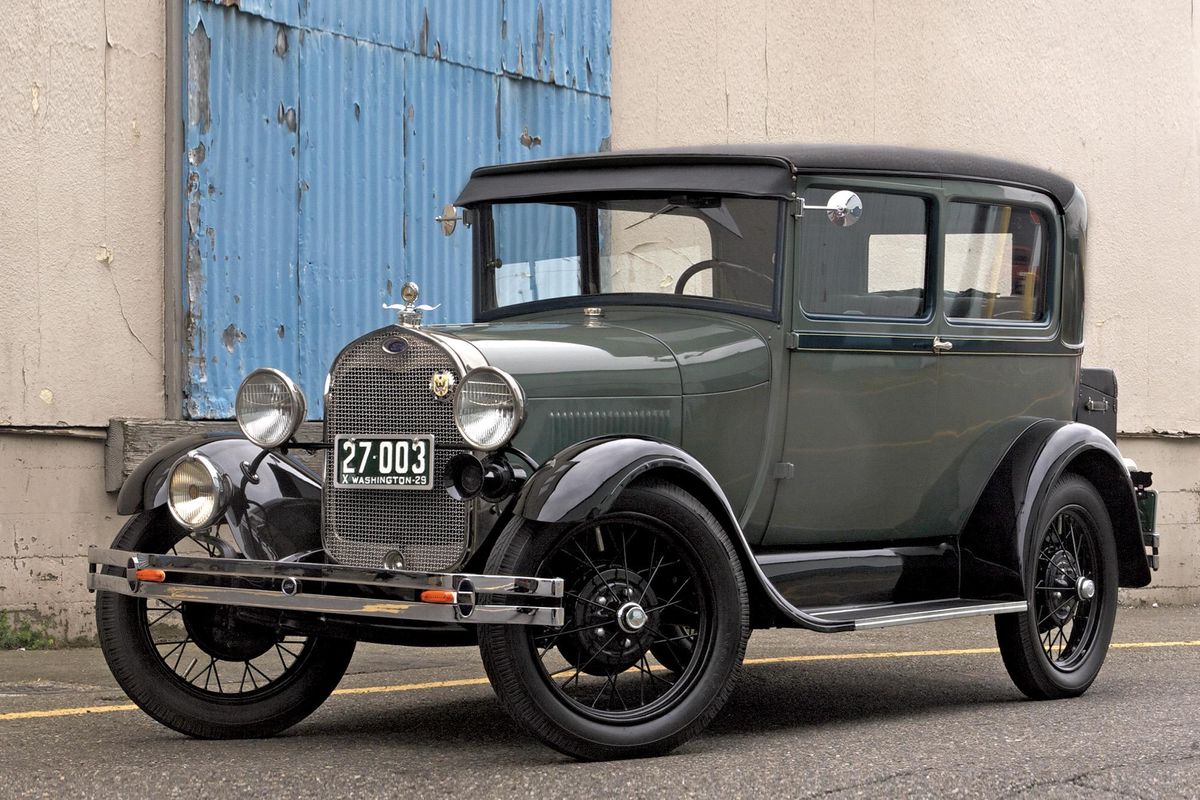
Photography from the Hemmings archives
Buyer's GuidesAlmost a century later, the Model A is still one of the easiest cars there is to own

The easiest collector cars in the world to own are those you can get the most parts for. You can probably name a lot of them: the ’55-’57 Chevy, the early Mustang, the first-generation Camaro, the Triumph TR6, the MGB, and so on. As grows the hobby, so does that list (as do the criteria for being on it - which now includes complete reproduction steel bodies), but since the beginning, that list has included the 1928-’31 Ford Model A.
The complete history of the Model A as a sensational new car - including its proven durability during the worst of conditions of the Great Depression and World War II, and its popularity as a simple and easily improved used car in the shortage-wracked postwar period - is too detailed to get into here, but suffice it to say that the historical popularity of the A translates to an extremely robust and complete aftermarket still supporting these cars on the eve of their centennial. Even in as-delivered form, the Ford Model A remains an eminently driveable car—married with some improvements developed when it was nearly new, it can traverse virtually any 21st century road with ease.
There are plenty of opportunities to do so, too. Two clubs serve the Model A hobby specifically: The Ford Model A Restorers Club (MARC) and the Model A Ford Club of America (MAFCA). They maintain technical libraries, advisors, and most importantly, communities of enthusiasts with whom to trade ideas, tribal knowledge, parts, and information. Both organizations are variously tolerant of modifications pioneered in the A’s earliest days as a used car, especially when the appearance is kept stock or made to resemble a period speedster or race car.

Many of those changes blend seamlessly into a road-ready car, ideal for participating in tours like those organized by MARC, MAFCA, and the local chapters thereof, plus multi-marque events run by other organizations. Moreover, unless you live in a really congested area, a touring-grade Model A makes a great fair-weather driver for any purpose —assuming your insurance provider and licensing authority agree.
Speedsters and more heavily modified cars will find themselves welcome at other sorts of events, including hill climbs and traditional hot rod gatherings like The Race of Gentlemen. Beware, though: Beyond a certain point, the more heavily modified the engine, the more temperamental it becomes and the shorter its lifespan.
The standard Ford closed body for all years of production was the two-door sedan (spelled Tudor by Ford, to complement its naming the four-door sedans Fordor). It also proved the most popular in original production, with 523,922 built in calendar-year 1929 alone (Ford didn’t track body-style production by model year) and 1,281,112 by the end of ’31 production in early 1932. Most in-demand today are the roadster and coupe bodies. The former is reproduced, and though repair panels are obtainable, no complete closed Model A body is. A late-1928 to 1931 Tudor makes perhaps the ideal Model A owner’s car for a variety of reasons, not least of which is the prospect of extra leg room in the front seats, attractive price point in the current market, and an all-steel body (compared with the wood-framed Fordors, built by outside suppliers). It’s on that specific model that we’ll focus here.
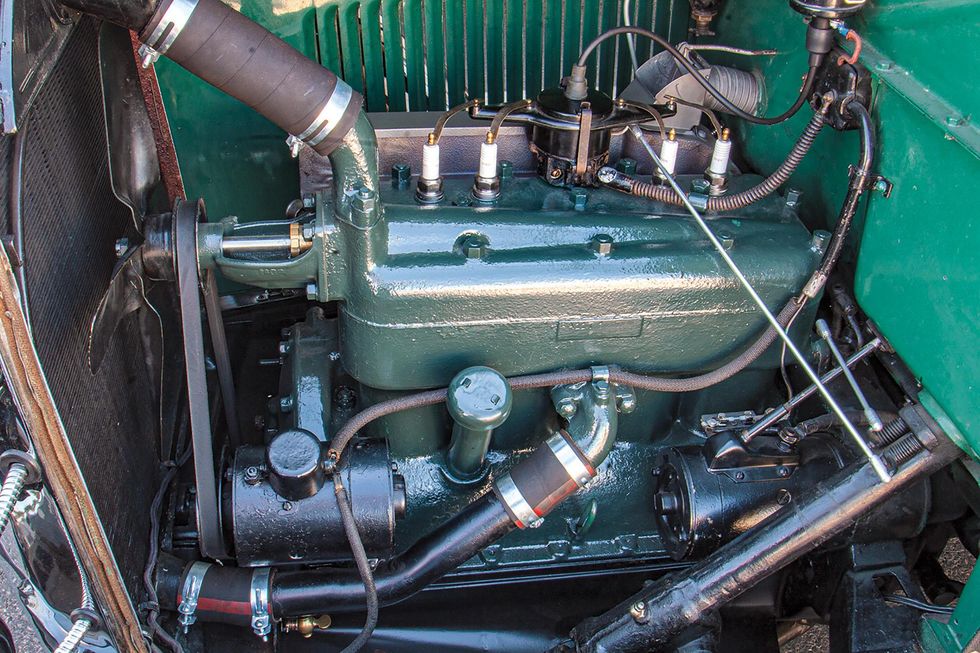 Courtesy of the Hemmings archives
Courtesy of the Hemmings archivesWhile it’s a flathead four-cylinder, and parts from the Model A engine have been made to work in the Model T block, there’s not much in common between the 177-cu.in. Model T engine and the 1928-’31 Model A engine, which displaced 200 cu.in. and made 40 hp at 2,200 rpm —twice the T’s 20 hp at 1,600 rpm. Famously, one reason the Model A is often seen wearing a quail radiator mascot is because its abrupt acceleration reminded operators of that bird bursting forth from the underbrush. The four-cylinder retained its reputation for quick starts right up through the V-8 era, when owners of “bangers” preferred to race from a standing or low-speed rolling start (the origin of the drag race) against V-8 owners. The V-8’s longer-legged nature was reflected in the popularity of the greyhound mascot on ’32-’34 Fords.
In its stock form with a heavy flywheel, the Model A engine remains a roadable unit, though it’s hard for most owners of driven cars to resist internal improvements when rebuild time comes along. Upgrades to the oiling system are popular, as are counterweighted Model B crankshafts (which permit a lightened flywheel and installation of a later clutch). Replacement of the poured bearings with modern-type inserts are frequently discussed, but probably overkill on anything but an engine regularly driven hard.
Top-end modifications, including additional carburetors (both stock-style updraft and later-style downdraft), high-compression (this is relative —stock used a 4.22:1 ratio) cylinder heads, high-performance camshafts, and free-flowing exhaust manifolds all exist and are of varying utility depending on the owner’s intended use of a Model A. Some more compression (Ford itself offered a Police head, though aftermarket heads usually boasted a superior chamber design and more compression yet—anything in excess of 6.5:1 is not advised with poured bearings), a distributor incorporating centrifugal advance (stock units are driver-adjusted from the steering wheel—not a situation favored by every modern driver), a Model B-grind camshaft, a downdraft two-barrel carburetor (Stromberg types being a good compromise between period tech, flexibility, and present-day parts availability), and a cast-iron exhaust manifold will give a healthy enough boost to any engine that you may wish to look into some of the brake upgrades discussed below.
Some A owners have gone even further than modifying the factory engine, yet without straying all the way into V-8 territory. More than one Model A has received, complete, the 50-hp four-cylinder engine originally found in a 1932-’34 Ford Model B. Aside from an external fuel pump, the Model B block looks very much like the Model A, yet it hosts oiling improvements and a counterbalanced crankshaft. Opinions diverge on whether the earliest 1932s had the balanced crank, but the real split in desirability seems to stem from Ford’s switch from sweated-on to cast-in counterweights, the latter of which aid immensely in rebuilding.
The Model B engine was originally packaged with a heavily revised transmission. The original Model A unit was scaled down from the big Lincoln transmission in use in the late 1920s — complete with multi-plate clutch. That clutch was soon replaced with a conventional disc unit, but the heavy flywheel and unsynchronized gears remained. When synchromesh was introduced to the marketplace, however, the consumer wouldn’t long stand for the necessity of double-clutching, and lighter flywheels had the added benefit of letting an engine gain rpm faster—though to the detriment of shifting unsynchronized transmissions.
For 1932, the Model B transmission was essentially that of the V-8 car, but in a gear case designed to work with the four-cylinder. In fact, gearsets from Ford passenger cars up through 1948 will fit in the Model B case, though it’s tight. Because the Model A bellhousing also mounts its pedals, many B-powered A’s will have been modified to accommodate the Model A oil pan, bellhousing, and transmission. Alternately, a variety of schemes have been worked up to use Model A pedals with later transmissions, including swaps intended for the Borg-Warner T-5 five-speed, the Ford SROD four-speed, and the 1932-’39 Ford V-8 three-speed.
Transmission choice complicates the rest of the driveline, as Ford cars built through 1948 had their driveshaft enclosed in a suspension member called the torque tube. The Model A axle, though theoretically not as strong as the V-8 units of 1933-’48, will mate with the later Ford transmission without modification to either. Adapters to fit the SROD and certain models of T-5 to the torque tube have been offered, and some enthusiasts choose to switch to an open driveline. That latter option is complicated, however, because the radius rods alone were not designed to deal with the braking and acceleration forces of the rear axle.
The Model A came with a standard gearing of 3.78:1 while V-8-era Ford axles were typically 4.11:1, so swaps to later rear axles are possible but rarely performed unless seeking added strength during a V-8 swap.
 Courtesy of the Hemmings archives
Courtesy of the Hemmings archivesThe Model A frame changed very little in over four years of production. Early on (over the first half of 1928), the braking system changed to separate the service brakes from the parking/ emergency brake, which left evidence not only in frame changes but in modifications to the splash aprons and the wheels. When a taller radiator on the 1930 models appeared, that required some changes as well, but in 96 years, necessity has resulted in the invention of ways to make things work together. In other words, don’t despair if you find evidence your 1929 was rebuilt sometime with a 1931 frame —as long as it was done right, it should be fine.
If a frame is out of whack, the simple, ladder design is easily straightened and repaired. Aftermarket frames, frame rails, and crossmembers exist, but they are aimed almost exclusively at the street rod part of the hobby— one exception being reproductions of the oft-mangled front frame horns. Stock or lightly period-modified cars usually stick with Ford pieces. Frame-up restorations aren’t as common for Model A’s as they once were, but should you find yourself with a car apart for some reason and are contemplating the aforementioned conversion to a V-8 transmission, drop-in crossmembers replicating modified 1932 Ford parts exist to accommodate both transmission and pedal mounts.
Modifications to the Model A braking system are hotly debated. The original four-wheel mechanical-drum system was a vast improvement over the Model T’s transmission brake acting only on the rear wheels, but even Ford saw fit to improve the system a few times before converting to hydraulic brakes for the 1939 model year—perhaps most notably in a switch from stamped-steel to cast-iron drums in the course of Model A production. From a performance standpoint, hydraulic drum brakes of the 1939-’48 Ford Lockheed design (or the 1936-’49 Chevrolet Houk design, for that matter) offer no improvement over properly adjusted mechanical drums of equivalent size and acting on an equivalent contact patch.
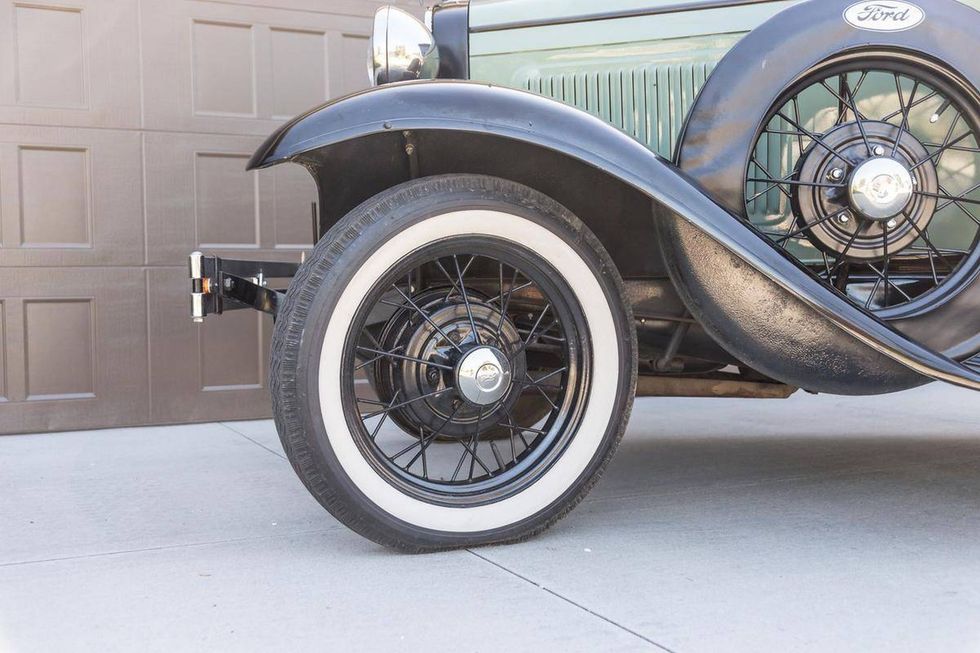
Courtesy of the Hemmings archives
Mechanical brakes are, however, far fiddlier to adjust than hydraulic systems and the modern hobbyist often doesn’t take much joy in that task. Luckily, neither did the 1940s DIYer, so the engineering of putting ’40-’48 Ford brakes on a 1928-’31 Ford was worked out long ago. Better yet, because those brakes are widespread in the traditional hot-rodding scene and the V-8 restoration scene, all the parts from backing plates and drums to wheel cylinders and shoes are available brand new.
On the flip side, if you’re evaluating a car that someone put “juice” brakes on years ago and it has been sitting, watch out. Mechanical brakes don’t go bad from lack of use, but hydraulics do!
If you’re looking for extra braking ability, aftermarket kits for fitting reproduction 1940s Lincoln self-energizing hydraulic brakes are available, as are modern linings and “floaters” for improving the friction and shoe contact in the stock mechanical system.
The braking system on a Model A has consequences where wheels and tires are concerned. The very early 1928 cars had brake drums and wheels unique to themselves. Thereafter, and through 1935, Ford mechanical brake drums had supports for the wire wheels incorporated into the face. Ford hydraulic brake drums from 1940-’48 had the same 5 on 5.5-inch bolt pattern, but lacked wheel supports. Add-on supports are advisable when running 1928-’35 wires on later hydraulic drums. Likewise, later Ford steel wheels don’t seat properly on the early drums.
Because of the commonality in bolt patterns, images in the ’30s and ’40s frequently show otherwise-stock A’s running around on 18-, 17-, and especially 16-inch wire-spoke wheels from later Fords. Even when the Model A was brand new, aftermarket wheels were a common accessory and popular for their ability to provide oversized tires with a greater cushioning effect.
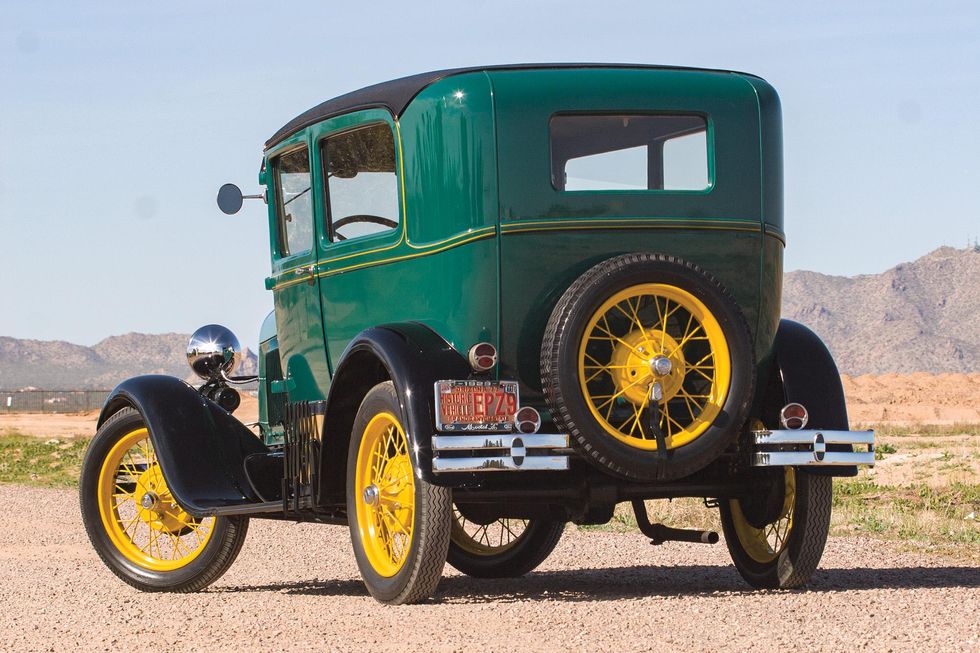 Courtesy of the Hemmings archives
Courtesy of the Hemmings archivesOften derided as “buggy sprung,” the transverse-leaf Ford suspension was simply a different approach from most of the industry, which preferred parallel leaves by that point. Because the basic system was used by Ford from 1909 to 1948, it became very refined. Because 1909-’48 parts underpinned most of American motorsport through the late 1950s, a lot of thinkers after Ford’s engineering staff have also worked on improving it.
As a road car, the well-maintained, in-spec Model A is fine unchanged. Roads today are generally much better than those of the early 1930s, so even a stock A can run up near its potential top speeds a lot of the time. The inclusion of a wheelbase of over 3.5 inches more than the Model T, plus hydraulic shock absorbers on all four wheels, meant that the A feels a lot more stable at higher speeds than its immediate predecessor. Still, there are sympathetic improvements to be made here based on later practice.
The Houdaille lever-action shock absorbers, if in good shape, should give fine service. Often, however, previous owners of even ostensibly “stock” driver-quality cars have discarded worn-out lever shocks for tube shocks. Ford itself made that change part way through 1947, and it’s a functional system that actually dates back to the 1930s on some non-Ford cars like Nash and Chrysler products, so “airplane shocks” are period tech that improve, rather than compromise handling if otherwise properly matched to the chassis.
Going further, without entirely departing from period practice, the Model A steering gear’s somewhat crude design was improved upon by 1937. Ford didn’t produce an easily interchangeable steering box until 1948 —though certain Nash and Hudson boxes from the ’30s were workable swaps as well. Today, aftermarket suppliers offer F-100 pickup-style steering that bolts right into an unmodified Model A and even contains provisions for the headlamp, horn, spark, and throttle controls. Like the synchronized three-speed from a V-8 Ford, the swap to a later steering box is said to turn a nice-driving little car into a great-driving one without sacrificing the essential experience of operating a vintage machine.
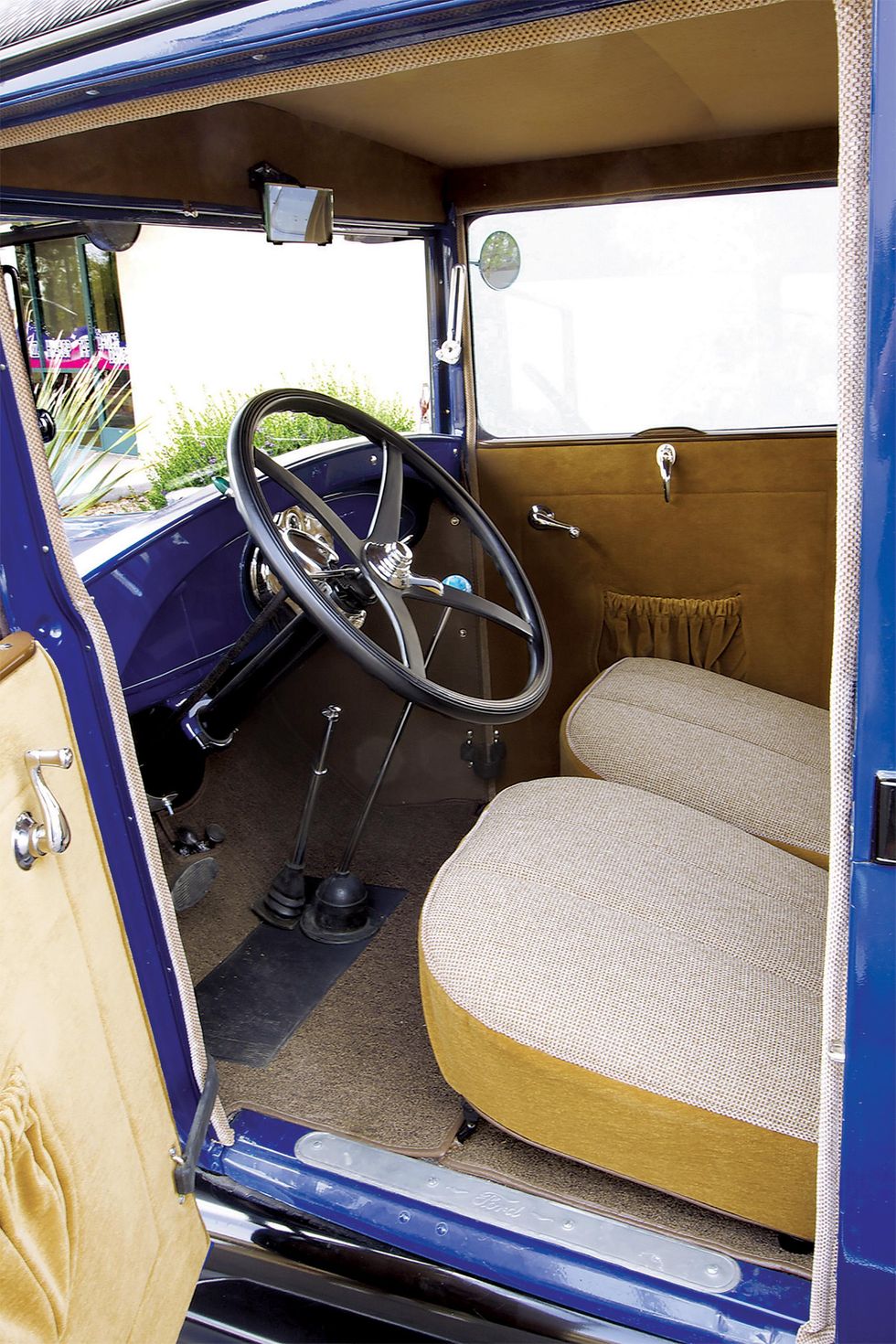 Courtesy of the Hemmings archives
Courtesy of the Hemmings archivesThe standard, five-passenger interior for all four years of production was covered in cloth rather than leatherette like the open cars. Shades varied from year to year, and carpets were replaced with rubber flooring sometime late in 1928. The oval-speedometer instrument panel of 1928-’29 was replaced for 1930-’31 by one with a round speedo. Accessory gauges —and panels to mount them like the dramatic Aristocrat panel made by Dunn Manufacturing Company in Clarinda, Iowa, which added spots for two additional instruments —have been popular additions since new and a set of refinished vintage pieces add utility to the simple Model A cockpit. Since the demise of famed supplier LeBaron Bonney, the Cartouche brand (owned by Mac’s and thus by Eckler’s) has seemingly become the go-to supplier for Model A interiors, though smaller operations like Classtique Upholstery in Lindstrom, Minnesota, haven’t gone anywhere either.
The Model A walked the line perfectly as a new car: inexpensive but not austere; simple but not grimly utilitarian. Those virtues make it a great car to own today. It’s capable, easily worked on, easily obtained, and above all—fun.
The Tudor sedan is perhaps the most essential of all Model A’s. Their initial popularity means they’re easy to find today and their comparatively sensible nature when compared to the glamorous roadsters, phaetons, and coupes mean that they’re not suffering from an overheated market due to competition from hot rodders.
If you’ve ever contemplated owning a pre-World War II car, it’s hard to recommend anything more highly than a Ford Model A Tudor.
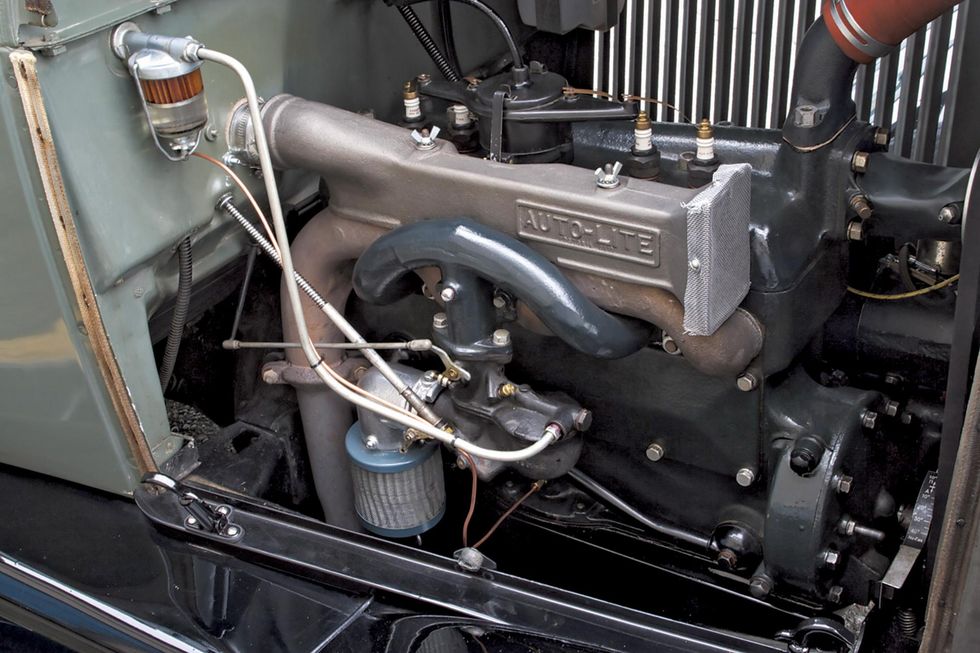 Accessories to increase horsepower or otherwise improve Model A performance have been around since the A was new. Note the add-on fuel and air filters, plus an Auto-Lite branded heater attached to its exhaust manifold.Courtesy of the Hemmings archives
Accessories to increase horsepower or otherwise improve Model A performance have been around since the A was new. Note the add-on fuel and air filters, plus an Auto-Lite branded heater attached to its exhaust manifold.Courtesy of the Hemmings archivesHood: $550
Plain front fender: $525
Welled front fender: $675
1930 running boards and splash aprons: $430/pr
Rear fenders: $800/pr
Cylinder head (new, 5.5:1 compression): $359
Generator-look 6V, pos.-ground alternator: $328
Hydraulic brake conversion kit: $3,560
Lincoln self-energizing brakes w/o drums (front): $425
Lincoln self-energizing brakes w/o drums (rear): $575
Lincoln brake drums: $160 (ea)
F-100 steering box conversion: $1,095
Adapter for Ford V-8 transmission: $679
1932-style transmission crossmember: $599
Wheel spacers for hydraulic drums: $75/set of 4
Reproduction 19- or 21-inch wire wheel: $625 (ea)
Firestone 4.50-21 tire: $245
Firestone 4.75-19 tire: $249
Cast-iron exhaust header: $395
Single downdraft intake manifold: $225
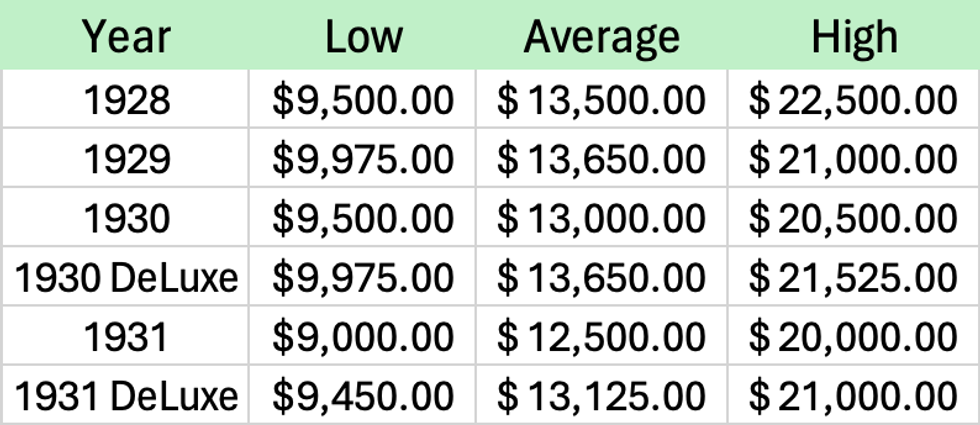

Courtesy of the Hemmings Archives
• Bratton’s Antique Auto Parts • 800-255-1929
• Brookville Roadster • 937-833-4605
• Classtique Upholstery • 800-208-9032
• Cling’s Aftermarket Products, Inc. • 480-777-1202
• C.W. Moss • 800-322-1932
• Early Ford Store of California • 909-305-1955
• Gaslight Auto • 800-242-6491
• Hot Rod Works • 208-455-7971
• Mac’s Antique Auto Parts • 800-284-3906
• Mike’s “A” Fordable • 888-879-6453
• Rootlieb, Inc. • 209-632-2203
• Snyder’s Antique Auto Parts • 888-262-5712
• Tam’s Model A Parts • 800-272-7871
• Vern Tardel’s Traditional Ford Hot Rod Shop • sales@verntardel.com
Interested? Please See: Ford Model A’s For Sale
Porsche has confirmed the official arrival of its hybrid 911 model, which will see its full debut on Tuesday, May 28. Whether or not sports car enthusiasts and Porsche aficionados accept the new hybrid as the newest 911 model, the sports car’s performance capabilities can’t be denied.
In its press release, Porsche boasted that its engineers logged over 3,000,000 test miles on the new 911. The hybrid was subjected to testing in the Artic Circle’s extreme cold environment and the unbearably hot deserts of Dubai, but Porsche didn’t stop there. Stop-and-go traffic scenarios were vigorously tested for drivers who plan to daily drive their new 911.
Perhaps the most impressive tests took place on the famous Nürburgring circuit. Porsche claims that Le Mans World Champion driver Jörg Bergmeister took the wheel, piloting the hybrid-powered 911 around the course in just 7:16.934 minutes, which is reportedly “8.7 seconds faster than the corresponding version of the predecessor model.”
Porsche has not yet released full performance data for the 2025 911, so it’s difficult to say exactly what those comparisons look like. Since the math makes sense, Porsche could be comparing the hybrid 911 to the 992 Carrera 4 GTS, which lapped the Nürburgring in 7:25.632. What we do know is that the 493-horsepower GT4 RS completed a lap at the Nürburgring in 7:03.121 minutes, just 14 seconds quicker than the road-going hybrid.
“For the first time in our icon’s 61-year history, we are installing a hybrid drive system in a roadgoing 911. This innovative performance hybrid makes the 911 even more dynamic,” Frank Moser, Vice President of 911 and 18 said. “We left nothing to chance during development and tested the new 911 under all sorts of conditions all over the world. Whether at a high drivetrain load in the demanding conditions of mountain passes or in the stop-and-go traffic of an urban environment, the new 911 has mastered even the most difficult challenges with aplomb."
Stay tuned for more details on May 28, when Porsche is scheduled to reveal the beginning of a new era, the hybrid 911 sports car.
In the early 1960s, Lotus debuted the Elan, an extremely lightweight, exceptionally small sports car. With its backbone chassis and fiberglass body, the Elan—available as a roadster or fixed-roof coupe—weighed a little over 1,500 pounds. A Ford Kent-based engine with a twin-cam, 16-valve cylinder head gave the diminutive sports car brisk performance, allowing the tiny Elan to punch well above its weight class. One thing thin the Elan was never noted for, however, was comfort, nor convenience, what with only two seats.
Enter the Elan +2, a much larger car built with the same design and engineering features, but with space for two children in the back and more comfort for the driver and front passenger. The Plus 2 debuted in 1967 and not long after an updated version, the +2S, was released with additional luxuries. Unlike the Elan, the +2 was only ever produced as a coupe. This 1972 Lotus Elan +2S 130 now offered on Hemmings Auctions appears to be a road-ready example of the first four-seater from Lotus. The “130” portion of the name came from the revised, higher-output 126-horsepower engine in the model released in the early 1970s.
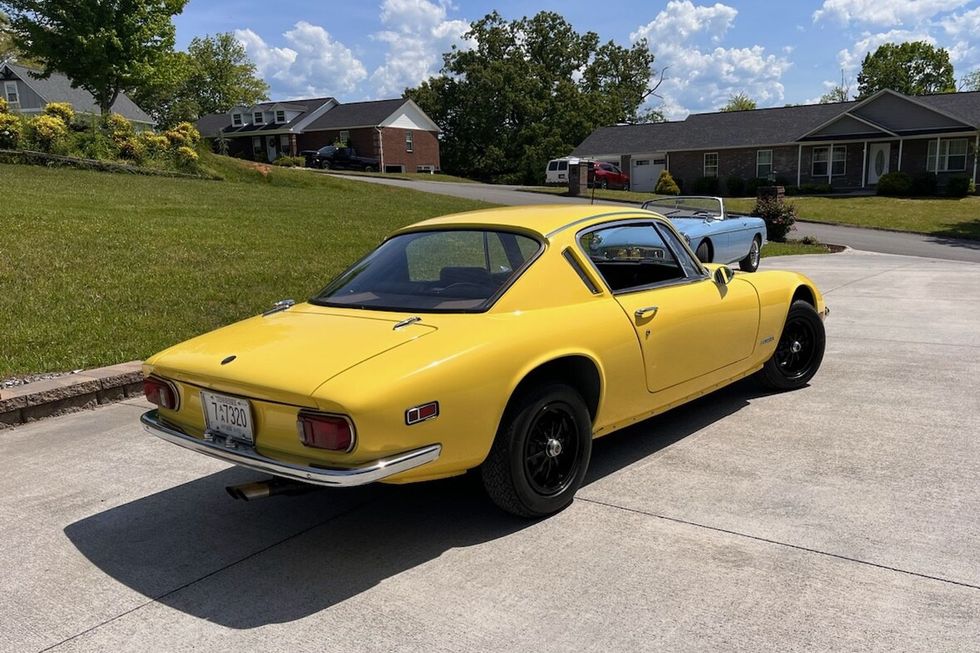
Like the original, the Elan +2S featured a backbone frame and a fiberglass body. Though still compact by almost any definition of a car from the 1960s, the four-seater was bigger in every dimension. Lotus designers and engineers were tasked with creating a car that “must be capable of transporting two adults and two children 1,000 miles in comfort with their luggage.” The Plus 2’s 96-inch wheelbase was a foot longer than the original. And its overall length of 169 inches was a full two feet longer than the earlier car. Additionally, it measured 10 inches wider and two inches taller. The Plus 2 was still relatively small, itself measuring one foot shorter in both wheelbase and overall length compared to a 1965 Ford Mustang Hardtop.
Those plus-size dimensions greatly contributed to the comfort inside the car, but with road testers of the day still praising the car for maintaining the Elan’s adroit handling. Motor Sport magazine from the U.K. described the Plus 2’s steering as “incredibly light and precise.” In detail, they wrote, “The all-round independent suspension with its racing-like wishbone and link lay-out gives the car superb handling, of that there is no doubt. The glory of it is that you can whip along country lanes with their twists and turns without drama, in complete safety and not working hard while drivers in lesser vehicles struggle to keep up.”
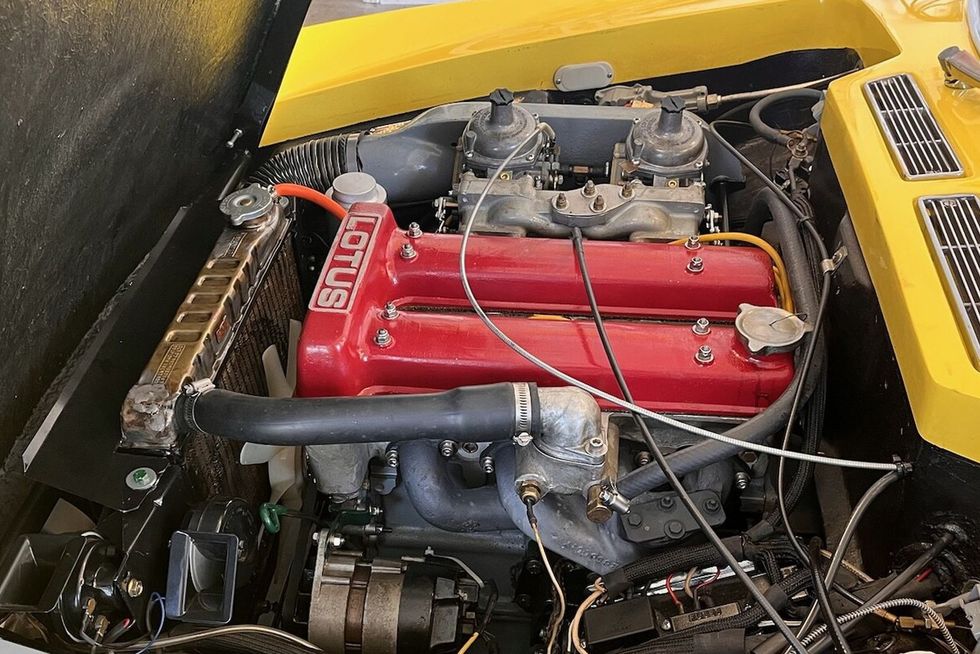
The “big-valve” version of the 1,558-cc Lotus-designed/Ford-based twin-cam four-cylinder engine in the +2S 130 was rated at 126 horsepower and 113 lb-ft of torque, giving the car brisk acceleration, as it weighed a little over 2,000 pounds. A four-speed manual directed power to the rear wheels. Road testers of the +2S and +2S 130 models reported 0-60 mph times at right around, or even just under, eight seconds.
Technically, by 1972, there was no such model as the Elan +2S. Rather, Lotus dubbed the car the +2S 130, or alternatively the Plus 2 130. In either case, despite the obvious origins and former use of the name with the model, “Elan” was dropped from the moniker by that time. The Elan name did reappear the following year. Though Elan production ceased in 1973, the Elan +2 continued through 1974.

The notes on this 1972 Lotus Elan +2S 130 currently listed on Hemmings Auctions indicate that this Plus 2 has been restored, including a rebuild of its original engine and four-speed manual transmission, completed some 3,000 miles ago. The seller shared that the water, oil and fuel pumps were replaced, while the radiator was rebuilt. Additional fresh components are said to be the brake discs, updated Rotoflex drive couplings and wheel bearings, all as part of a chassis rebuild.
The seller reports that the fiberglass bodied was disassembled, repaired and professionally refinished before reassembly. The original brightwork was rechromed as necessary and the original glass reinstalled with new seals. Fresh Pirelli Cinturato rubber was mounted on refinished original Lotus 10-spoke alloy wheels. According to the Classic Lotus Elan Register, this +2S 130 is one of 1,879 +2S and +2S 130 models built out of a total production run of 5,139 Elan +2’s.
Take a look at this 1972 +2S 130 at Hemmings Auctions to see what a right-sized Lotus Elan looks like.
